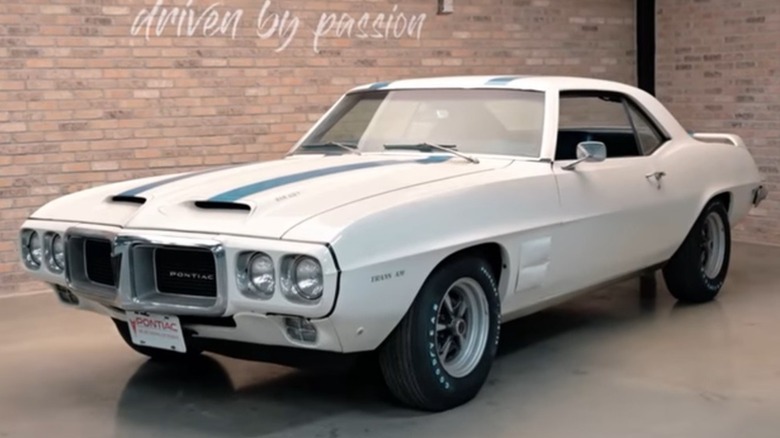What Happened To Pontiac's Legendary Ram Air V Engine?
As the horsepower war between automakers in the 1960s forged the Muscle Car era, the need to deliver increased fuel to V8 combustion chambers became evident to engine designers. But without enough oxygen, pumping more fuel into the intake just led to fuel-rich conditions and fouled spark plugs.
Engineers formed different strategies to get more air into, and out of, an engine's cylinders. Some used hemispherical combustion chambers, known as Hemi engines, that allowed the use of larger intake and exhaust valves due to the raised chamber's increased surface area. Others employed similar designs, such as the Ford Boss 429. Pontiac increased air flow to its V8 engines with Ram Air technology.
The Pontiac Ram Air V8 ranks among the most iconic engines from the golden era of muscle cars. Pontiac improved its Ram Air engine lineup over several iterations, culminating with the Ram Air V –- its name shortened to RA V in some circles -– in 1969. Its performance potential is legendary, a status no doubt fueled by its rarity. Since the Ram Air V was developed to support Pontiac's racing initiatives, it saw limited production to meet required homologation rules. Pontiac Ram Air V production ceased after SCCA rule changes in 1970, which coincided with General Motors moving away from its focus on muscle cars.
The Pontiac Ram Air V engine program was short-lived
Pontiac produced Ram Air V components for engine displacements such as 303-cubic-inches for SCCA competition, 366-cubic-inches for NASCAR, 400-cubic-inches planned for production GTOs and Firebirds, and 428-cubic-inches for NHRA drag racing. The plan was to build enough Ram Air V cars to satisfy the SCCA's homologation rules, designed to ensure a desired level of production car status for the cars that competed in the series. The idea was to prevent the teams with the most money from winning all of the races.
The Ram Air V design received its first blow when the SCCA changed its rules for the 1970 racing season. At the same time, one of the main suppliers for parts on the engine went under, making production more difficult. However, the Ram Air V met its ultimate demise in the boardroom, where GM executives decided its fate with little concern for people's feelings. As rising gasoline prices and stricter emissions standards throttled the golden age of the muscle car, GM went all in on the Chevrolet Corvette and had little appetite for developing a Pontiac to compete with it.
What's different about the Pontiac Ram Air V?
The main difference between the Pontiac Ram Air V and other small block GM iterations, including previous Ram Air versions and the notorious small block Chevy, was the complete redesign of the cylinder heads. Previous V8 small block engines from GM, such as the Pontiac 350 and Chevy 350, use cylinder heads with the valves arranged so that the two inboard cylinders have exhaust valves and ports located next to each other. Most small block GM heads at the time had rectangular or D-shaped intake and exhaust ports, although some high performance versions featured round ports.
Pontiac, perhaps inspired by Ford's Tunnel Port cylinder head design, rearranged the valve layout in the Ram Air V heads, swapping the two inboard cylinders to put the intake valves, not exhaust, in close proximity. The new arrangement allowed for larger valves and more exhaust flow. It also required passing pushrods through the intake ports.
Would the Ram Air V be a good street engine?
A late 1960s or early 1970s Firebird or GTO with the Ram Air V engine would be a welcome addition to any collector's garage. However, it may not be the best choice for driving around town. While it could be driven on the street, the Ram Air V was designed for high rpm performance — not an endearing trait for a daily driver.
While the 428-cubic-inch Ram Air V could produce acceptable low rpm torque with the free-flowing design due to the sheer volume of air it moves at idle, smaller Ram Air V engines could not. An engine needs some velocity to its airflow to carry the air-fuel mixture into its cylinders. Try blowing out a candle with your lips pursed as you normally would, compared to blowing it out with your mouth wide open.
Another aspect of Pontiac's Ram Air system that we haven't discussed is the functional hood scoop. Before the Ram Air V came along, that was the major upgrade provided by the Ram Air option. The increased airflow provided through the hood scoop was a key element to the Ram Air V system's performance.


